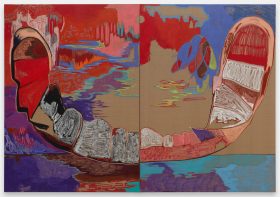“A starving artist…sacrifices material well-being in order to focus on their artwork. They typically live on minimum expenses, either for a lack of business or because all their disposable income goes towards art projects. Some starving artists desire mainstream success but have difficulty due to the high barriers in art such as visual arts, the film industry, and theatre. These artists frequently take temporary positions (such as waitering or other service industry jobs) while they focus their attention on breaking through in their preferred field.”
— Wikipedia, Starving Artist
Money is such a dirty word, such a dirty idea, for a true artist.
Many artists, when speaking about what motivates them to work, speak about a “need”, to say something. This “calling,” rather like a persistent neurosis or a religious bent, is difficult to translate into a straightforward career trajectory. The will to create is a fundamentally anarchic impulse, like the sex drive: it knows no parameters and does what it will. And yet, in a society in which everything must be commodified and saleable, even sex – which necessitates no advertising to induce our participation – is repackaged and plastic-wrapped as pornography, and sold, sold, sold.
But can we translate that drive into a marketable commodity, and if so, does it mean that we should? How do the visual arts fit into the “Society of the Spectacle? ”
Western culture, in the main, has variously interpreted the artistic urge as lunacy, rebellion, or a bad disposition. Nobody seems to be offering any guidance as to how those who are compelled to create are supposed to survive in a world in which we’re programmed to consume. Those artists living on the fringes, though – and they do still exist – seek, and find, ways to live without conforming to the expectations of the working world.
Jan Maris, a painter living and working in Amsterdam and coming out of the political scene of 1980s Europe, never went to art school and has said in an interview with Arts Hub that this fact alone continues to inform his work as an autonomous artist. Maris lived and painted for years in squats and buses (oil painting in a camper beats writing poetry in a garret hands-down for artistic dedication). Despite being broke and bus-bound, Maris has consistently refused commissions that he finds uninteresting, even when offered huge sums. Asked about his motivation, Maris said: “As I’m less ‘programmed’ for the normal, regular way of living than normal, regular people, I can still walk around this world in complete wonder. It is a handicap for which I thank God on my bare knees every night.”
At the same time in Britain, Margaret Thatcher was busy reworking the national curriculum. The new curriculum did just about everything, short of banning the arts outright, to deter the budding artistic impulse in school-age children. Art, it seemed, had no future in a factory age, in which we’re all supposed to be high-functioning, commodity-producing automatons somewhere in the corporate pyramid. In a paper given at Keele University in 2001, ex- schoolteacher Ken Jones said that Thatcher’s reforms had “installed a rigid and prescriptive educational framework, consequently squeezing the principles of creativity and autonomy out of teaching and learning.”
Meanwhile, an ambitious young ad mogul called Charles Saatchi – yes, that Saatchi – had kept himself busy during those years, masterminding the campaign that put Thatcher into 10 Downing Street in the 1979 elections. Fifteen years later, Saatchi found a way to make art marketable. In 1997, Saatchi gathered his collection: the crop of the shocking, the cocky, the rock n’ roll of the young Brit-art world, and launched it upon an unsuspecting London in “Sensation”, opening up a new commercial heyday for the visual arts in Britain.
In marketing – or commodifying – new art, Saatchi created a paradigm which started to creep into art schools and studios: suddenly, artists and art students had to sell, or at least to think about selling. To quote Francesca Gavin, writing in 2005 on bbc.co.uk: “…something’s recently been happening in British art schools, particularly on the fine art courses. The teaching at the London Institute has changed dramatically over the past 20 years. Tutors are bombarded with paperwork and bureaucracy. Students are forced to create work which is ideas-based and have to continually defend their work. Blame Margaret Thatcher’s legacy, blame the popularity of conceptualism, but the result is homogenised, bland and bad art… When did creative expression have to tick the boxes?”
Graeme Walker, born in 1980 in Thatcher’s Britain, and now, despite his education, a working artist in Britain and Europe – has always struggled with the box-ticking. He spoke about this to Arts Hub, saying in interview that “if you are just starting out being serious about what you do – and if you are not producing much in the way of commodity – a certain slowness must be anticipated in financial terms. Having said that, I have no qualms about receiving money to make things happen, to keep a roof over my head or to keep the loan-sharks at bay. Artists should be paid well for what they do because they have an important job to do that’s worth paying for. Getting what you want is part of the work. It’s really damn hard, but it’s worth it. [It’s] all I have and it’s all I want.”
Graeme Walker made a lovely little thing called The Drift Book (available in all good book-art shops), which can best be described as a paean to doing nothing very much at all. One page features the artist himself, drinking a beer from a can, and wearing a t-shirt that bears the words “I UNDERMINED THE GREAT BRITISH WORK ETHIC.”
Margaret Mayhew is a friend of mine. A life model, PhD student, and artist based in Sydney whose work, in her own words, extends to “Reading, Writing, Drawing, Rabble Rousing — All performed professionally and at reasonable cost.” She earns enough life-modelling, performing and painting to fund her own exhibitions, but that’s it. “I can make art from garbage,” she wrote in a recent email regarding the subject of this article. It almost looks as though the true artists have retained their passion and their vision by dropping out of mainstream society, including art schools and galleries.
From Warhol – who made his own world in a derelict warehouse and gathered round a bunch of genuinely subcultural freaks to create a brave new paradigm – to the bravely anonymous Banksy, whose rejection of the gallery scene and the commodity-factor have paradoxically made him one of the most popular figures in recent pop culture, it looks like our role as artists in society is to keep asking difficult questions, and to keep rejecting the neat and controlled pigeonholes to which our kind and our work is relegated.
If you can do that, fully uncompromised, and get paid for it, that’s like winning the game without even having to play. As Graeme Walker put it: “Society takes a very hard line towards the way that many artists choose to live and work, so making money can get you a sense of justification. Having said that, I think these feelings are misplaced – based on a conditioned assumption that society is “right”. I personally feel the need to challenge these feelings.“
As soon as the likes of Hirst and Emin are featured in galleries, it’s time to get out of the gallery and on to the walls of the city, CCTV or no. As soon as the Hollywood A-list get their hands on the figures of Warholian myth, it’s time to drop those figures from the role models list and start becoming our own role models. Each and every one of the artists that I interviewed, when asked whether they would stop doing what they do if they could never make any money, resoundingly answered no. Money and status aren’t everything: WH Auden even wrote that, “Art is born of humiliation.” We’ve all got to serve somebody, but the muse can’t be seduced by money alone. If money is dirty, then the creative urge is pure: an impulse older than money and belonging to an altogether different part of the self.
Once again, though, Graeme Walker put it best: “You cannot buy happiness or a higher sense of your own worth, but you can buy yourself dinner and that always makes you feel better.”
Vist the artists quoted:
Jan Maris
Graeme Walker
Margaret Mayhew




